The BlackBerry PlayBook Review
by Anand Lal Shimpi on April 13, 2011 9:00 PM EST- Posted in
- Tablets
- Smartphones
- RIM
- BlackBerry
- PlayBook
- Mobile
I suppose it's fitting that I should be the one to write our PlayBook review. Before Android and the iPhone, there were two mobile platforms/devices that I was hugely fond of: the Palm V and my BlackBerry. In fact, it wasn't until the iPhone that I finally let go of my last BlackBerry - moving on from the email era into the smartphone age.
Today's BlackBerry is of course very different than the devices I used in college. And the PlayBook is unlike anything RIM has ever done.
I don't believe any tablet maker has perfected the formula just yet. I made that abundantly clear in our review of the iPad 2. While you can't argue that Apple is the forerunner in the smartphone based tablet space, over the long term I still believe this is anyone's game. Remember, the leaders in the early days of the PC industry weren't the ones who ultimately dominated the mature market.
What follows is our review of RIM's first attempt at building a tablet. The PlayBook is far from perfect, but there's a foundation here that can be built upon if RIM has a good roadmap and good execution. And if you're a BlackBerry user, there's a lot of synergy to exploit.
| BlackBerry PlayBook Pricing Comparison | |||||
| 16GB | 32GB | 64GB | |||
| WiFi | $499 | $599 | $699 | ||
Let's get to it.
The Hardware
If we view the primary difference between the first and second generation of smartphone based tablets as being ergonomics and performance, the PlayBook falls squarely in between the two.
At 10mm thick the PlayBook (7-inch display) is more iPad 1 (9.7-inch) or Xoom (10.1-inch) than iPad 2 or Galaxy Tab 8.9, but what RIM lacks in thinness it makes up for in overall size. The PlayBook is an almost-pocketable tablet. Bigger than the 5-inch Streak and even bigger than the 7-inch Galaxy Tab, the PlayBook isn't a pain to port around. The PlayBook is small enough to snugly fit inside the outer pocket of a long men's winter coat or a lady's purse. While I definitely don't carry my iPad everywhere, if it were more functional I could see carrying the PlayBook with me more often than any other tablet.
The PlayBook's styling is modest, even for BlackBerry standards. The front has a single BlackBerry logo along the bottom bezel and a visible camera lens but that's it. Around back you've got RIM's logo, a larger lens for the rear-facing 5MP camera sensor and a sea of black.
The only buttons on the device are along the top of the PlayBook: power, volume down, pause/play and volume up. The power button is flush with the surface of the PlayBook's edge. You basically need a pointy finger nail (which I typically don't have) to press it easily and as a result the power button was pretty much useless to me. If you can manage to hit it the power button will lock the PlayBook, otherwise you'll have to leave the tablet idle until it automatically goes into standby. RIM tells me that final versions of the PlayBook will have this power button raised by 0.8mm, enough to make it easily clickable.
Press and hold the power button and you'll be greeted with a PC-like choice to either power off the PlayBook or restart it. I'm not sure how frequently RIM expects you to do the latter, but when testing it's a nice feature to have.
The volume up/down buttons work as expected, although the volume level itself doesn't seem to be very linear. There's a single 1/8" headphone jack up top, near a port for the PlayBook's microphone.
The PlayBook features a pair of pretty loud stereo speakers on the front of the device. Being used to the iPad's single speaker, the PlayBook's two speakers are nice.
Charging is always an issue on these USB devices. You can take Apple's approach and charge over USB, which unfortunately can take a while to fill up a tablet's battery. You also run into issues with older computers that don't support the USB Charging spec, resulting in charging-only-while-sleeping like the iPad. Then there's Motorola's approach with the Xoom where you don't charge over USB but have a dedicated port for an AC adapter. Charging times are significantly reduced but now you need to carry around an extra adapter with you wherever you go. RIM arrived at what's quite possibly the best solution. The PlayBook will charge over USB and it also features a higher amperage quick-charge port for use with some of its accessories.
The battery is of course not removable and there's no USB port or SD card reader.
The Form Factor
The PlayBook is only slightly larger than Samsung's 7-inch Galaxy Tab and maintains the same 7-inch screen size (albeit with a functional border around the screen). Given my complaints about current tablets not being incredibly portable compared to a smartphone, you'd think that I'd love the PlayBook's form factor. To be honest, for portability, I do.
| Tablet Specification Comparison | |||||
| Apple iPad 2 | BlackBerry PlayBook | Motorola Xoom | |||
| Dimensions | 241.2mm x 185.7mm x 8.8mm | 194mm x 130mm x 10mm | 249.1mm x 167.8mm x 12.9mm | ||
| Display | 9.7-inch 1024 x 768 | 7-inch 1024 x 600 | 10.1-inch 1280 x 800 | ||
| Weight | 601g (WiFi only) | 425g | 730g | ||
| Processor | 1GHz Apple A5 (2 x Cortex A9) | 1GHz TI OMAP 4430 (2 x Cortex A9) | 1GHz NVIDIA Tegra 2 (2 x Cortex A9) | ||
| Memory | 512MB | 1GB | 1GB | ||
| Storage | 16GB up to 64GB | 16GB up to 64GB | 32GB + microSD card | ||
| Pricing | $499 up to $829 | $499 up to $699 | $599 - $799 | ||
While I'm almost never tempted to bring the iPad with me when I'm going around town, the PlayBook is a far easier sell. It's almost pocketable (and actually pocketable if I'm wearing a big jacket) and isn't too heavy.
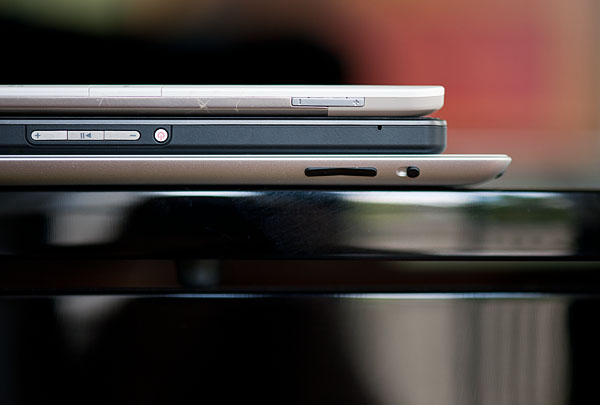
From top to bottom: Amazon Kindle 2, BlackBerry PlayBook, Apple iPad 2
Even when I'm not out and about, the PlayBook is quite usable as a content consumption device. In portrait mode fonts are a bit too small for me to read comfortably on the couch but in landscape it works well as a reddit browsing machine.
It's in the couch-lounging usage model that the PlayBook does fall short of the iPad or Xoom. But in terms of portability the PlayBook is clearly a much better balance of functionality and mobility. If you read between the lines you'll come to the same conclusion I have: neither the PlayBook nor the iPad is the perfect form factor for a tablet. Further more, I'm not sure there is a single perfect tablet form factor.
Apple tends to be a one-size-fits-all company when it comes to iOS. You want a smartphone? That'll be a 3.5-inch screen on an iPhone. Want a tablet? 9.7-inch iPad. It's interesting given how carefully Apple selected its four notebook sizes: 11, 13, 15 and 17-inches.

Clockwise: Apple iPad 2, Amazon Kindle 2, BlackBerry PlayBook in Convertible Case
Ultimately I don't think tablets will fall into the one-size-fits-all category. Instead I believe they're ultimately headed for some sort of a convergence with netbooks or notebooks. Today that's difficult to see because they lack a common hardware ISA, OS and even apps, but you don't have to look too far into the future to see those problems going away.
While I appreciate the PlayBook's portability and would definitely carry it around more than an iPad, it's not as nice to use laying back on a couch. The screen is too small to comfortably read in portrait mode and even in landscape things can get a bit cramped.
RIM's market research shows a clear preference for portability, hence the PlayBook's introductory 7-inch form factor. However RIM also pointed out that the BlackBerry comes in all shapes and sizes, indicating that the PlayBook would ultimately be available in different form factors as well. RIM also indicated that the 7-inch PlayBook may not be the smallest size offered either. Clearly RIM views the tablet market much like the notebook market: there will be ultraportables and there will be workhorses, with tons of choice in between. The 7-inch PlayBook is merely a starting point. Assuming RIM can fund the projects, we'll likely see both larger and smaller siblings in the future.


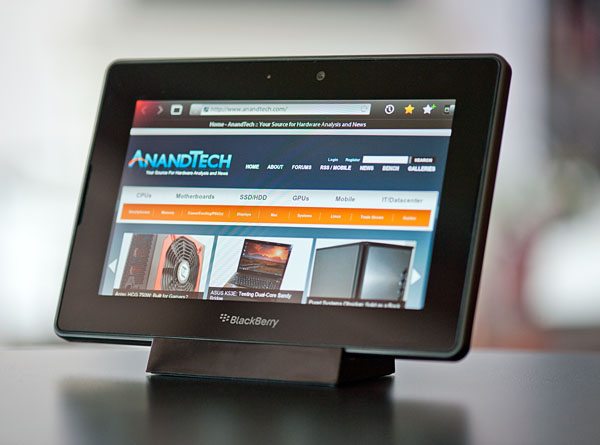
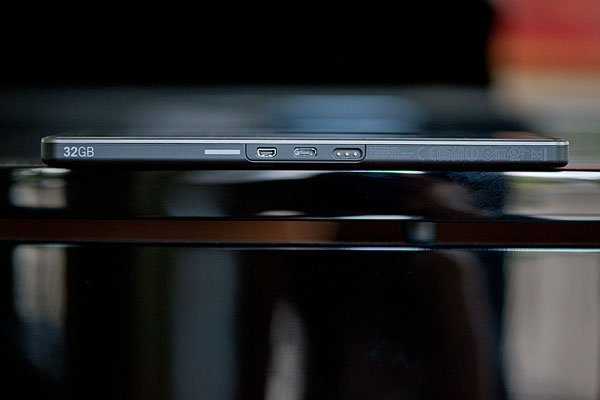
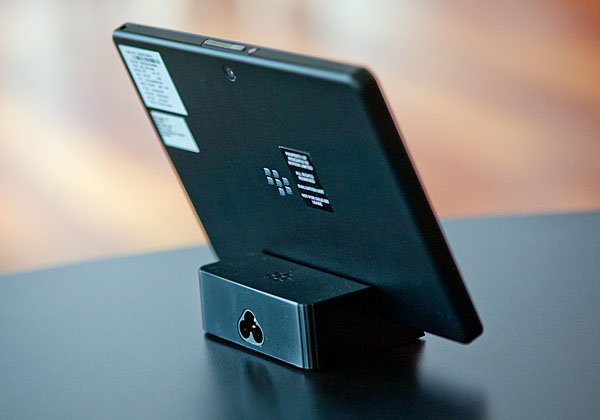
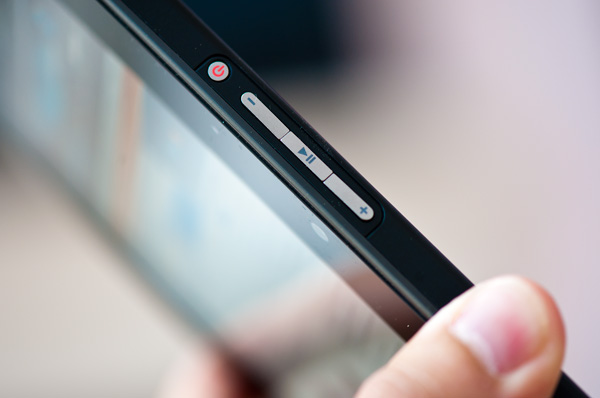
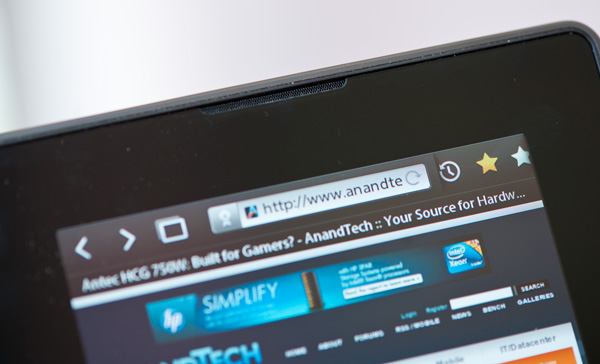








77 Comments
View All Comments
tipoo - Wednesday, April 13, 2011 - link
Did you have anything running in the background there? Gizmodo and Engadget both got within 10% of the iPad 2's score, the one here seems to be much slower.Anyways, as usual this is easily one of the best reviews.
Anand Lal Shimpi - Wednesday, April 13, 2011 - link
This may be a sunspider 0.9 vs. 0.91 issue, RIM said the same thing but 0.9 for some reason gives us the scores you see on the PlayBook vs. the competition (just re-ran again to be sure).I'm still waiting for a response from RIM as to why the relative performance comparison is much worse under 0.9. We've stuck with 0.9 to maintain backwards compatibility with our older smartphone numbers but if need be I'll switch over to 0.91 for tablets.
I'm running 0.91 numbers now, let's see what I come up with.
Thanks for reading and your kind words :)
Take care,
Anand
Anand Lal Shimpi - Thursday, April 14, 2011 - link
This is definitely a 0.9.1 vs. 0.9.0 issue. I'm not sure what is causing the PlayBook to choke on 0.9.0. I will update the article with 0.9.1 numbers as well.Take care,
Anand
8steve8 - Wednesday, April 13, 2011 - link
very high black levels on the screen is disappointing. (samoled/samoled+ is amazing)Also the bezel looks like its a huge percentage of the surface area, which is ugly.
7" seems to be the worst size, too big for pockets, too small for ideal consumption of entertainment or web.
The Base OS seems decent, although without email or calendar, we will have to give this another look in august.
That said, I still find tablets a niche device that few situations actually call for. Usually I find myself wanting a physical keyboard, or at least more screen space while typing. Also if you have to constantly hold it up, or buy a stand, why not use little laptops laptops, the screens don't need a stand : )
I find it a good device for a coffee table or any profession where you are standing/not at a table. Otherwise I'll stick to smartphone/laptop or desktop.
Solandri - Thursday, April 14, 2011 - link
The contrast ratio is the same as the iPad 2, so the high black levels is an artifact of the high white levels. In other words, if you turned down the brightness to match the max brightness of the iPad 2, the black levels should be the same as on the iPad 2.Along the same lines, I'm wondering what was the brightness setting during the battery tests. Usually reviewers do something like set brightness to half during the battery tests. But that seems a bit unfair since the Playbook's screen is so much brighter than the competition's. Wouldn't a more fair comparison be to set its brightness output to be the same number of nits as the iPad 2 in its battery test? In effect, think of the screen as the same as the iPad 2, but with the option to really crank up the brightness if you're outdoors in sunlight.
Anand Lal Shimpi - Thursday, April 14, 2011 - link
So our old method was to set everything to 50%, but lately I've been doing brightness matching right around ~150 nits on these tablets.Take care,
Anand
HilbertSpace - Wednesday, April 13, 2011 - link
Conclusion page:"I'm glad to see RIM experimenting with form factors. After using the Galaxy Tab 8.9 at CTIA I felt that may be the perfect balance between portability and functionality. The 7-inch PlayBook "
- something got mixed up there.
Aikouka - Wednesday, April 13, 2011 - link
I wonder if the browser would be better if you had the option to hide the menu/address bar?Anand Lal Shimpi - Thursday, April 14, 2011 - link
You actually do have the option to hide the menu/address bar, it's in the upper right corner of the browser. That does improve things but it also makes it less convenient to navigate to the next website.Take care,
Anand
jjj - Wednesday, April 13, 2011 - link
In the final words it would be worth reminding readers that it has no SD card slot, IMO a fundamental feature for phones/tablets nowdays.